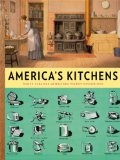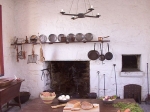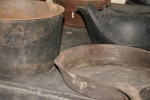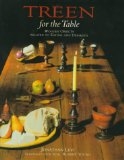-
History of:
- Resources about:
- More:
- Baby walkers
- Bakehouses
- Bed warmers
- Beer, ale mullers
- Besoms, broom-making
- Box, cabinet, and press beds
- Butter crocks, coolers
- Candle snuffers, tallow
- Clothes horses, airers
- Cooking on a peat fire
- Drying grounds
- Enamel cookware
- Fireplaces
- Irons for frills & ruffles
- Knitting sheaths, belts
- Laundry starch
- Log cabin beds
- Lye and chamber-lye
- Mangles
- Marseilles quilts
- Medieval beds
- Rag rugs
- Rushlights, dips & nips
- Straw mattresses
- Sugar cutters - nips & tongs
- Tablecloths
- Tinderboxes
- Washing bats and beetles
- Washing dollies
- List of all articles
Subscribe to RSS feed or get email updates.
Encyclopedia of Kitchen History by Mary Snodgrass
from Amazon.com
or Amazon UK
Nancy Carlisle, America's Kitchensfrom Amazon.com
"...articles required for the kitchen of a family in the middle class of life..." in 1861 in the UK, according to Isabella Beeton:
- Tea-kettle
- Toasting-fork
- Bread-grater
- Pair of Brass Candlesticks
- Teapot and Tray
- Bottle-jack
- 6 Spoons
- 2 Candlesticks
- Candle-box
- 6 Knives and Forks
- 2 Sets of Skewers
- Meat-chopper
- Cinder-sifter
- Coffee-pot
- Colander
- 3 Block-tin Saucepans
- 5 Iron Saucepans
- Ditto and Steamer
- Large Boiling-pot
- 4 Iron Stewpans
- Dripping-pan and Stand
- Dustpan
- Fish and Egg-slice
- 2 Fish-kettles
- Flour-box
- 3 Flat-irons
- 2 Frying-pans
- Gridiron [girdle, griddle]
- Mustard-pot
- Salt-cellar
- Pepper-box
- Pair of Bellows
- 3 Jelly-moulds
- Plate-basket
- Cheese-toaster [fork]
- Coal-shovel
- Wood Meat-screen [to stop heat escaping from fire while roasting, with shelves for warming plates]
- Total cost: £8 11s 1d
Kitchen Antiques
Historic kitchen equipment, culinary objects
>>Resources divided into:
>>Museum collections of culinary objects
>>Fireplace cooking, cast iron
>>18th and/or 19th century kitchen items
>>Early 20th and/or 19th century >>Earlier and miscellaneous
Or jump down to the page to Victorian advice on equipping a kitchen
 Old or historic kitchen utensils go by various different
names from "culinary antiques" to "vintage kitchenalia". Whether they're ancient
or mid-20th century "retro", almost all old food preparation, serving, and storage
items appeal to some collector somewhere.
Old or historic kitchen utensils go by various different
names from "culinary antiques" to "vintage kitchenalia". Whether they're ancient
or mid-20th century "retro", almost all old food preparation, serving, and storage
items appeal to some collector somewhere.
Many objects are easy to identify, but not all. It's not always clear if a simple box or pot or implement had a particular name or a particular use. A collection of jars (earthenware, stoneware, glass in the 20th century) and boxes (wooden, tin) was needed when food was stored at home and groceries were sold unwrapped. Households had different beaters, paddles, and bats - some of them known as beetles - for purposes from tenderising meat to working butter to beating the dirt out of clothes. Simple wooden boards, stirring sticks, and large spoons had a wide range of uses. As it says in the article about pudding sticks linked below, "The most plebeian of kitchen tools are sometimes the hardest to identify."Lower down the page are excerpts from 19th century housekeeping advice manuals to give some idea of "normal" kitchen equipment then, in the UK and the USA.
Sometimes kitchen collectibles are categorised according to what they are made of. Wood (treen), tinware, copper, stoneware etc. Some of the less well-known materials include tôle or toleware - painted tin-plated sheet-iron - and American Agate Ware and Graniteware. (See first link in resources list) In the kitchen these last two describe particular kinds of enamelware, with a finish resembling agate or granite, although both names can refer to ceramics as well.
Online resources about antique, historic, or old kitchen and food utensils
Museums and museum-like collections with a range of different culinary objects
- Food preparation in 19th century USA - from cherry pitter to vinegar measure
- Victorian kitchen and table tools
- Kitchen equipment from Wales - from a medieval "lime-powered" cooking pot to carved apple scoops
- Household tools and equipment from New York Historical Society's online folk art collection - includes sausage grinder, spoon stand, and pie crimper
- New England - type "kitchen" in search box for 19th century collection including toasting iron, pot hooks, bean pot
- Cook's tools at the Belgian Museum for Old Techniques
- Culinary objects at the Gourmet Museum near Liège
- Domestic equipment - Australian collection with food and drink categories to explore
- Mostly Victorian kitchen things - pastry jigger, food chopper etc. - and a few Tudor food- and drink-related items.
- Treen (wooden) food-related items - from c1700 on
- Treen drink-related items - from c1600 on
- Use search-term 'culinary' at V & A collection for lots of cutlery - also see their Dutch cabinet kitchen, late 17th C
- Culinary objects - a cross-cultural collection The Rietz Collection of Food Technology
- Museum of London - variety of culinary objects - Search page
- Food, eating and drinking - wide range of images
- British culinary equipment - from different periods
Fireplace cooking and cast iron
- Spits, spit-jacks, bottle-jacks - roasting meat over a fire
- More roasting equipment - spit engine, clock jack, smoke jack
- Cooking equipment at Fort Scott, Kansas, mid-1800s
- Cast iron cookware - waffle irons, wafer irons, skillets and more
- Frying pans
- 1812 wafer iron
- Griswold cast iron
Other 18th and/or 19th century food preparation and storage items
- Jelly moulds/molds, cake and pie moulds, and many other culinary moulds/molds
- Hanging salt box - 1797
- Russian salt cellars - salt thrones/chairs
- Apple corers - from late 17th century on
- Earthenware - storage jars, pitchers etc. from Virginia, Tennessee and nearby
- Redware - American red earthenware
Mostly early 20th and/or 19th century
- 1902 Appliances/Kitchen Department from Sears & Roebuck Catalog
- Domestic life and household management - 247 images including vintage electrical and mechanical kitchen items
- Late 19th century kitchen gadgets from Canada - apple parer, egg beater, can opener
- Pyrex
- Collecting kitchenalia
- Aluminumware (aluminium)
- Orange squeezers, reamers, juicers
- Egg coddlers
- Kitchen utensils from 1940s USA
- Baking - mid-20th century
- Cornish ware includes stamps and dating
- Guardian Service cookware
- Kitchen utensils in 20th century England - oral history
- 20th century kitchen collectibles - cookie jars etc. - no dates
- Pie birds and pie funnels
- Kerala, India - wooden kitchen equipment
Earlier and miscellaneous culinary objects
- Drinking and serving vessels - England, approx. 1000-1600
- The Tudor kitchen
- Cooking equipment in medieval France
- Renaissance kitchen equipment
- Roman culinary objects
- Links to medieval images - scroll down to Gastronomical Material Culture
- Traditional Indian kitchenware
- Cutlery of different eras
- Chafing dishes
- Pudding sticks - mush sticks
- Porridge spurtle - not so different from the pudding sticks
- Nutmeg graters
- Rolling pin
- Tea kettles
Jonathan Levi, Treen for the Table: Wooden Objects Relating to Eating and Drinking, from Amazon.comor Amazon UK

Kitchen and food-related articles on this site:
- Baking over an open fire: bannocks and flat breads
- Baking peels and paddles
- Beer warmers, ale mullers
- Butter churns
- Butter crocks
- Bread ovens shared by a community
- Enamel kitchenware history
- Game pie dishes
- Hasteners and meat screens
- Nutcrackers
- Pottery - earthenware
- Pressure cookers
- Roasting jacks and string roasting methods
- Sugar nippers
- Tureens shaped like poultry
Articles on antique culinary objects at HomeThingsPast.com, our companion site
- Links to articles about things used for cooking, dining, drinks etc.
- Follow-up page, more culinary articles, for instance:
- Spoon warmers, salt boxes, tea caddies, rotary egg beaters, vintage icebox.
Advice on equipping a kitchen in the 19th century
Catherine Beecher had firm ideas about what was needed for a well-run household. Her list for the 1840s kitchen in the USA included:
Tin Ware
...bread pans, large and small pattypans, cake pans, with a centre tube to ensure their baking well, pie dishes, (of block tin,) a covered butter kettle, covered kettles to hold berries, two saucepans, a large oil can, (with a cock,) a lamp filler, a lantern, broad bottomed candlesticks for the kitchen, a candle box, a funnel or tunnel, a reflector, for baking warm cakes, an oven or tin kitchen, an apple corer, an apple roaster, an egg boiler, two sugar scoops, and flour and meal scoop, a set of mugs, three dippers, a pint, quart, and a gallon measure, a set of scales and weights, three or four pails, painted on the outside, a slop bucket, with a tight cover, painted on the outside, a milk strainer, a gravy strainer, a colander, a dredging box, a pepperbox, a large and small grater, a box, in which to keep cheese, also a large one for cake, and a still larger one for bread, with tight covers.
Wooden Ware
...a nest of tubs, a set of pails and bowls, a large and small sieve, a beetle for mashing potatoes, a spad or stick for stirring butter and sugar, a breadboard, for moulding bread and making pie crust, a coffee stick, a clothes stick, and mush stick, and meat beetle to pound tough meat, an eggbeater, a ladle for working butter, a bread trough, (for a large family,) flour buckets, with lids to hold sifted flour and Indian meal, salt boxes, sugar boxes, starch and indigo boxes, spice boxes...
In a prosperous American household in 1871 a "prudent and generous mistress" would supply her cook "with ample provision of all such things as her important department requires..."
...such as tables, shelves, closets, pasteboards [pastry boards], sieves, tubs, pails, rolling-pins, trays, pots, pans, colanders, strainers, skimmers, a saw, hatchet, cleaver, scissors, mallet, sausage-grinder and stuffer, coffee-toaster, coffee-mill, tea-kettles, pots, mortar and pestles, soap, candles, ovens or a first-rate stove or range, tin baking-pans, furnaces, bell-metal [alloy of copper and tin] kettles, porcelain kettles and stew-pans, towels, boiling-cloths [pudding cloths], bread-towels, dish-cloths, salt, pepper, spices, etc., spice-mills, egg-beaters, strainers, ladles and flesh-fork [for lifting meat from a pot], bread-toasters, knives and forks, spoons, skewers, aprons, a kitchen clock, etc. All these articles are indispensable, and there are a great many other useful implements which modern ingenuity has brought into use, and which it would be well to introduce into a fully-arranged kitchen.
(Mary Ann Bryan Mason)
A book aimed at an English couple setting up home in a small cottage in the first half of the 19th century advised:
A good copper tea-kettle is the most durable (this is an article I don't know how to persuade you to do without, though some writers cry out bitterly against it). The round shape will be two or three shillings cheaper than the oval, and bears mending better. It is not quite so fashionable, but that you have too much good sense to mind. The beauty of a copper kettle is in its durability and brightness, not its shape; and the two or three shillings saved will buy you a handy little saucepan, or gridiron, or frying-pan: these two last articles, no matter how seldom they are used, yet most people like to have such things in their house.
You should have two strong iron pots, of different sizes; one or other of which, I hope, will be in frequent use. I would wish a working man to have a bit of something hot most days. One pot might do, but not so well, for this reason, you cannot boil anything large in a small pot; and though you might boil what is small in a large one, there would, by so doing, be more firing and time taken up than is necessary. For any very nice, particular purpose, such as boiling milk, starch, or gruel, there is nothing answers better than bell-metal or brass, which also lasts long.
A Nottingham-ware [brown stoneware] pot, with a lid, to hold a gallon or two, is very useful; especially if you have an oven: it does well to make a stew or soup, on which I shall give you a hint presently.
(Esther Copley)
You may like our new sister site Home Things Past where you'll find articles about antiques, vintage kitchen stuff, crafts, and other things to do with home life in the past. There's space for comments and discussion too. Please do take a look and add your thoughts. (Comments don't appear instantly.)
For sources please refer to the books page, and/or the excerpts quoted on the pages of this website, and note that many links lead to museum sites. Feel free to ask if you're looking for a specific reference - feedback is always welcome anyway. Unfortunately, it's not possible to help you with queries about prices or valuation.









